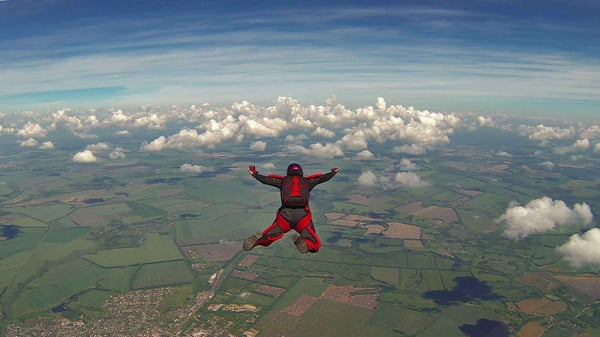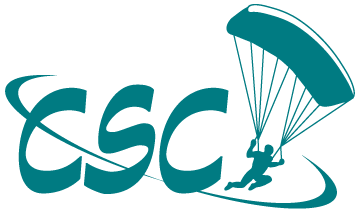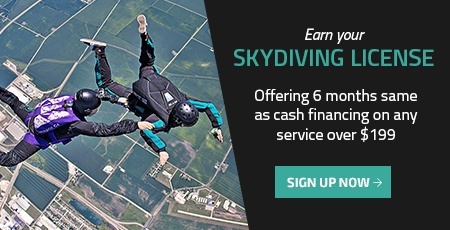Many first-time skydivers make the mistake of thinking they’ll be jumping out of an airplane alone... but that’s not how it works.
Any novice’s first few plunges will be tandem jumps, where you’re safely strapped to a certified tandem jump instructor. But how many tandem jumps do you need before going solo?
In this post, we’re talking about solo skydiving requirements: everything you need to know to become a licensed skydiver and freefall solo from any dropzone in the world.
Understanding the Tiers of Skydiving Licensing

After you’ve made a few tandem jumps and caught the skydiving bug, you’ll want to study up on the varying levels of skydiving licensing.
Just like any expert invests hours-upon-hours of work mastering their craft, so too do certified skydivers. They go through rigorous levels of schooling and application to earn higher and higher ranks of skydiving status.
There are four tiers of skydiving licensing, including skydiving A through D licenses, each with more advanced instruction.
Good news though. For you to go solo, you’ll only need a USPA A License.
Solo Skydiving Certification Requirements
Generally speaking, your USPA A License requirements aren’t too extensive when compared to some of the more advanced levels of jump school (like getting your tandem instructor license!)— but it still requires a lot of studying, training and focus to achieve.
You’ll have to take some skydiving classes and learn the basics, such as:
- Your skydiving equipment - Including all about your harness, parachutes, etc.
- How to properly exit the aircraft and land
- Proper body positioning and movement during freefall - This includes controlling your degree of turn, barrel rolls, front flips and backflips
- Canopy skills - how to control your parachute during the descent and landing
- Emergency procedures - what to do if something goes wrong.
Here’s a sneak peek of the USPA’s A License Proficiency Card.
Specific skydiving requirements like on the card include:
- “Above 2,500 feet, perform a maximum-performance 90-degree toggle turn, followed immediately by a turn of at least 180 degrees in the opposite direction (two times)”
- “Using an aviation winds aloft forecast, select the correct exit and opening point.”
- “Change or adjust a main closing loop.”
- “Jump and deploy while stable within five seconds after exit from 3,500 feet AGL.”
And that’s just a taste. For how many jumps you need to skydive alone, plus more, let’s look at what the United States Parachute Association lists as its solo skydiving requirements:
- Complete all requirements laid out by the USPA A License Proficiency Card
- Complete a minimum of 25 freefall skydives (including tandems)
- Make five skydives with one or more other people
- Pass the USPA written and oral exams
- Get skydiving license stamped by the USPA
That’s right. You’ll take classes, perform graded challenges and have to take a written exam before you can freefall by yourself. You will also need an active USPA membership for any license to remain current.
HOW TO SKYDIVE SOLO: CLASSES
You’re probably curious about the solo skydiving classes you’ll need to achieve licensed status. You’ll begin with a ground school course and including instruction on equipment, parachute packing, and flight regulations.
Then, you’re ready for the sky. Your in-air classes are going to vary based on the skydiving center you choose, but if you enroll in the Freefall University here at CSC with our experienced instructors, they can take you through the 7 levels of AFF (Accelerated Freefall) training jumps to learn how to solo skydive. Click each link for a video!
- Freefall University Level 1 Solo Skydive. Achieve stability, pull on your own and land safely.
- Freefall University Level 2 Solo Skydive. Stable exit, two turns and stable pull.
- Freefall University Level 3 Solo Skydive. Stable exit, unassisted heading control and stable solo pull.
- Freefall University Level 4 Solo Skydive. Stable floating exit, controlled turns, altitude awareness and unassisted pull.
- Freefall University Level 5 Solo Skydive. Solo exit, gain stability unassisted, delta track on instructor’s heading and unassisted pull.
- Freefall University Level 6 Solo Skydive. Unassisted floater exit, circle of awareness, practice touch and barrel roll initiation.
- Freefall University Level 7 Solo Skydive. Diving exit, circle of awareness, practice touch and initiate back loop.
In addition to these observed 1-on-1 jumps with USPA coaches, you’ll leave with the smarts and skills you need to take your written exam and apply for your USPA A license with confidence.
Ready to Go Solo?
If you’re ready for solo skydiving, you’re in luck. Our Chicagoland Skydiving Freefall University (Freefall U) can get you trained and certified in no time.
Click the link above to see our course dates and enroll today.


